Development Law of Water-Conducting Fracture Zone in the Fully Mechanized Caving Face of Gob-Side Entry Driving: A Case Study
Abstract
:1. Introduction
2. Case Analysis: Working Face Profile of Gequan (GQ) Coal Mine
3. Analysis on the Development Height of WCFZ
3.1. Theoretical Formula Analysis
3.2. Numerical Simulation Analysis
3.2.1. Model Establishment and Parameter Selection
3.2.2. Analysis on Numerical Simulation Results
3.3. On-Site Detection Analysis
3.3.1. Analysis on the Borehole Imager Observation Results
3.3.2. Analysis on the Fluid Leakage Observation Results
4. Theoretical Analysis on the Development Law of WCFZ in Fully Mechanized Caving of GSED
4.1. Comprehensive Detection Results of WCFZ and Reliability Analysis
4.2. Theoretical Analysis on the Instability of Narrow Coal Pillars and the Overburden Height in Fully Mechanized Caving of GSED
5. Conclusions
- (1)
- This study takes the working face 11915 in Coal Mine GQ as the research object. The development height of the WCFZ in fully mechanized caving of GSED was studied by means of theoretical calculation, numerical simulation, and on-site detection (i.e., borehole imager observation and fluid leakage observation). The obtained values are 48.3–60 m, 46 m, 45.54 m, and 46.4–47.2 m, respectively.
- (2)
- A structural model of WCFZ development caused by the instability of narrow coal pillars in fully mechanized caving of GSED was established. The difference between WCFZ heights in the working face 11915 by numerical simulation and on-site detection was analyzed, and the accuracy of on-site detection and numerical simulation data was verified.
- (3)
- The overburden failure degree in fully mechanized caving of GSED transforms from insufficient mining to sufficient mining. The shape of the WCFZ in the overburden changes from an arch to a saddle, and the development height of WCFZ jumps. It is found that the height (24 m) of overburden WCFZ in the working face 11915 under insufficient mining is 52.17% of that (46 m) under sufficient mining.
Author Contributions
Funding
Acknowledgments
Conflicts of Interest
References
- Hou, C. Ground Control of Roadways; China University of Mining and Technology Press: Xuzhou, China, 2013. [Google Scholar]
- Hua, X. Development status and improved proposals on gob side entry retaining support technology in China. Coal Sci. Technol. 2006, 34, 78–81. [Google Scholar]
- Ding, K.; Tong, Y. Development and Prospect of pillar free mining in China(first). Coal Eng. 1984, 03, 11–16. [Google Scholar]
- He, M.; Gao, Y.; Yang, J. The energy-gathered roof cutting technique in non-pillar mining and its impact on stress evolution of surrounding rocks. Chin. J. Rock Mech. Eng. 2017, 36, 314–325. [Google Scholar]
- Sun, H.; Zhao, B. Theory and Practice of Retaining Roadway along Goaf; China Coal Industry Publishing House: Beijing, China, 1993. [Google Scholar]
- Guo, Y.; Bai, J.; Hou, C. Study on the main parameters of gateside packs in gateways maintained along gob- edges. J. China Univ. Min. Technol. 1992, 21, 1–11. [Google Scholar]
- Jia, Y. State of art and future of new techno1ogy in back filling a1ong roadway sides in China coal mines. Coal Sci. Technol. 1993, 3, 2–6. [Google Scholar]
- Kang, H.; Zhang, X.; Wang, D.; Tian, J.; Yi, Z.; Jiang, W. Strata control technology and applications of non⁃pillar coal mining. J. China Coal Soc. 2022, 47, 16–44. [Google Scholar]
- Hou, C.; Li, X. Stability principle of big and small structures of rock surrounding roadway driven along goaf in fully mechanized top coal caving face. J. China Coal Soc. 2001, 26, 1–7. [Google Scholar]
- Zhang, W.; Zhang, D.; Chen, J.; Xu, M. Control of surrounding rock deformation for gob-side entry driving in narrow coal pillar of island coalface. J. China Univ. Min. Technol. 2014, 43, 36–42. [Google Scholar]
- Liu, T. Influences of mining activities on mine rockmass and control engineering. J. China Coal Soc. 1995, 20, 1–5. [Google Scholar]
- Qian, M.; Miao, X. Theoretical analysis on the structural form and stability of overlying strata in longwall mining. Chin. J. Rock Mech. Eng. 1995, 14, 97–106. [Google Scholar]
- Xu, J.; Zhu, W.; Wang, X. New method to predict the height of fractured water-conducting zone by location of key strata. J. China Coal Soc. 2012, 37, 762–769. [Google Scholar]
- Fan, L. The scientific problems faced by water-preserving coalmining. J. China Coal Soc. 2019, 44, 667–674. [Google Scholar]
- Yi, T.; Han, X.; Weitao, Y.; Wenbing, G.; Erhu, B.; Tingye, Q.; Dawei, Y.; Bingyuan, H.; Hao, C.; Minghao, S. Study on the Overburden Failure Law of High-Intensity Mining in Gully Areas with Exposed Bedrock. Front. Earth Sci. 2022, 10, 833384. [Google Scholar] [CrossRef]
- Yuan, L. Strategic thinking on the co-excavation of coal and gasin my country. J. China Coal Soc. 2016, 41, 1–6. [Google Scholar]
- Yi, T.; Hao, C.; Shuang, G. Field Study on the Law of Surface Subsidence in the High-Intensity Fully Mechanized Caving Mining Working Face with Shallow Thick Bedrock and Thin Epipedon in Hilly Areas. Adv. Mater. Sci. Eng. 2021, 2021, 6515245. [Google Scholar]
- Yang, D.; Guo, W.; Zhao, G. Height of water-conducting zone in longwall top-coal caving mining under thick alluvium and soft overburden. J. China Coal Soc. 2019, 44, 3308–3316. [Google Scholar]
- Cao, Z.; Wang, Q. Development characteristics of water-conducting fracture zone based on the structural effect of overlyingstrata. Coal Geol. Prospect. 2020, 48, 145–151. [Google Scholar]
- Mallı, T.; Yetkin, M.E.; Özfırat, M.K.; Kahraman, B. Numerical analysis of underground space and pillar design in metalliferous mine. J. Afr. Earth Sci. 2017, 134, 365–372. [Google Scholar] [CrossRef]
- Yetkin, M.E.; Arslan, A.T.; Zfrat, M.K.; Kahraman, B.; Yenice, H. Numerical Modelling of Stress-strain Analysis in Underground thick coal mining. Int. J. Eng. Res. Technol. 2018, 7, 199–204. [Google Scholar]
- He, C.; Lu, W.; Zha, W.; Wang, F. A geomechanical method for predicting the height of a water-flowing fractured zone in a layered overburden of longwall coal mining. Int. J. Rock Mech. Min. Sci. 2021, 143, 104798. [Google Scholar] [CrossRef]
- Li, T.; Gao, Y. Research on the impactof large-scale coal mining in desert shoals on the impact of diving. Min. Res. Dev. 2019, 39, 100–103. [Google Scholar]
- Safety Supervision and Administration. Code for Coal Pillar Retention and Coal Pressure Mining of Buildings, Water Bodies, Railways and Main Roadways; China Coal Industry Publishing House: Beijing, China, 2017. [Google Scholar]
- Wu, X.; Bo, Z.; Yang, K.; Yang, J. Application of 3DEC Numerical Simulation Method in Roadway Support Optimization Design. Min. Saf. Environ. Prot. 2013, 40, 73–76. [Google Scholar]
- Liu, C. Numerical simulation study with 3DEC on impacted movement of hard roof in manless working face extraction. Rock Soil Mech. 2004, 285–288. [Google Scholar]
- Zhai, Z.; Meng, X.; Wu, Z.; Xu, S. Height determination of water flowing fractured zone based on borehole imaging observation. Coal Eng. 2020, 52, 89–93. [Google Scholar]
- Yao, Q.; Li, X.; Zhu, L.; Yan, K.; Yang, P.; Xia, Z. Development and application of in-situ testing system for geomechanical parameters of coal and rock mass. J. China Univ. Min. Technol. 2019, 48, 1169–1176. [Google Scholar]
- Liu, Y. Research on Panoramic Drilling Imaging Measurement System for Coal Mines. Coal Technol. 2020, 39, 61–65. [Google Scholar]
- Li, X.; Huang, Q. High development characteristics of water flowing fractured zone in fully-mechanized top-caving mining of extremely thick coal seam under water. J. Min. Saf. Eng. 2022, 39, 54–61. [Google Scholar]
- Guo, W.; Lou, G. Definition and distinguishing method of critical mining degree of overburden failure. J. China Coal Soc. 2019, 44, 755–766. [Google Scholar]
- Liu, G.; Zhang, H.; Liu, Z. Observation and simulation research on development features of overlying strata failure in conditions of fully-mechanized top-coal caving mining under river. J. China Coal Soc. 2013, 38, 987–993. [Google Scholar]
- Tan, Y.; Guo, W.; Yang, D. Analysis on height of “two zones” under subcritical mining in shallow coal seam with hard roof. J. Min. Saf. Eng. 2017, 34, 845–851. [Google Scholar]
- Lu, S.; Liu, S.; Wan, Z.; Zhang, H.; Xing, K.; Ta, X. Deformation and Control Measures of Narrow Coal Pillar in Gob-Side Entry. Min. Res. Dev. 2020, 40, 28–31. [Google Scholar]
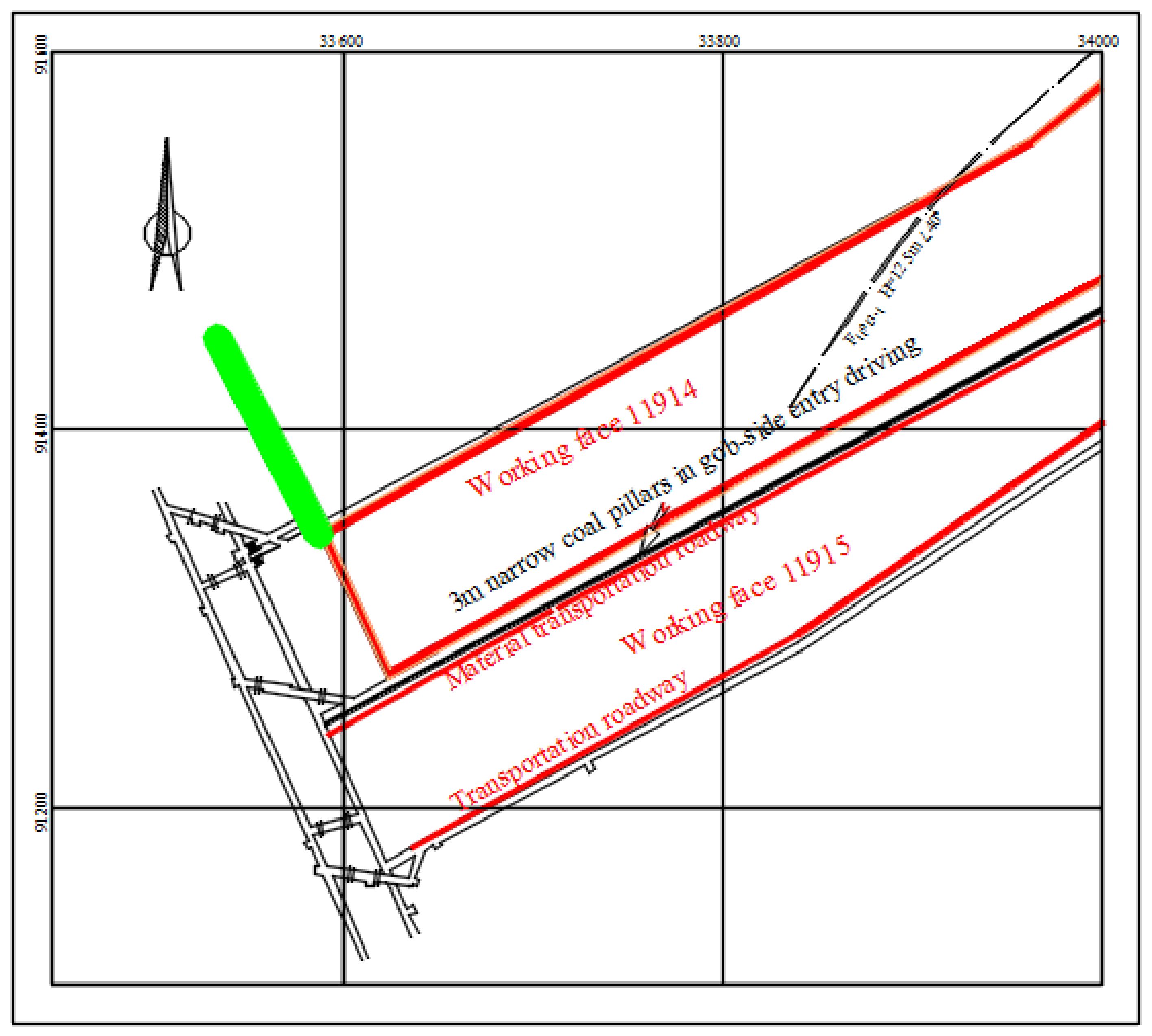
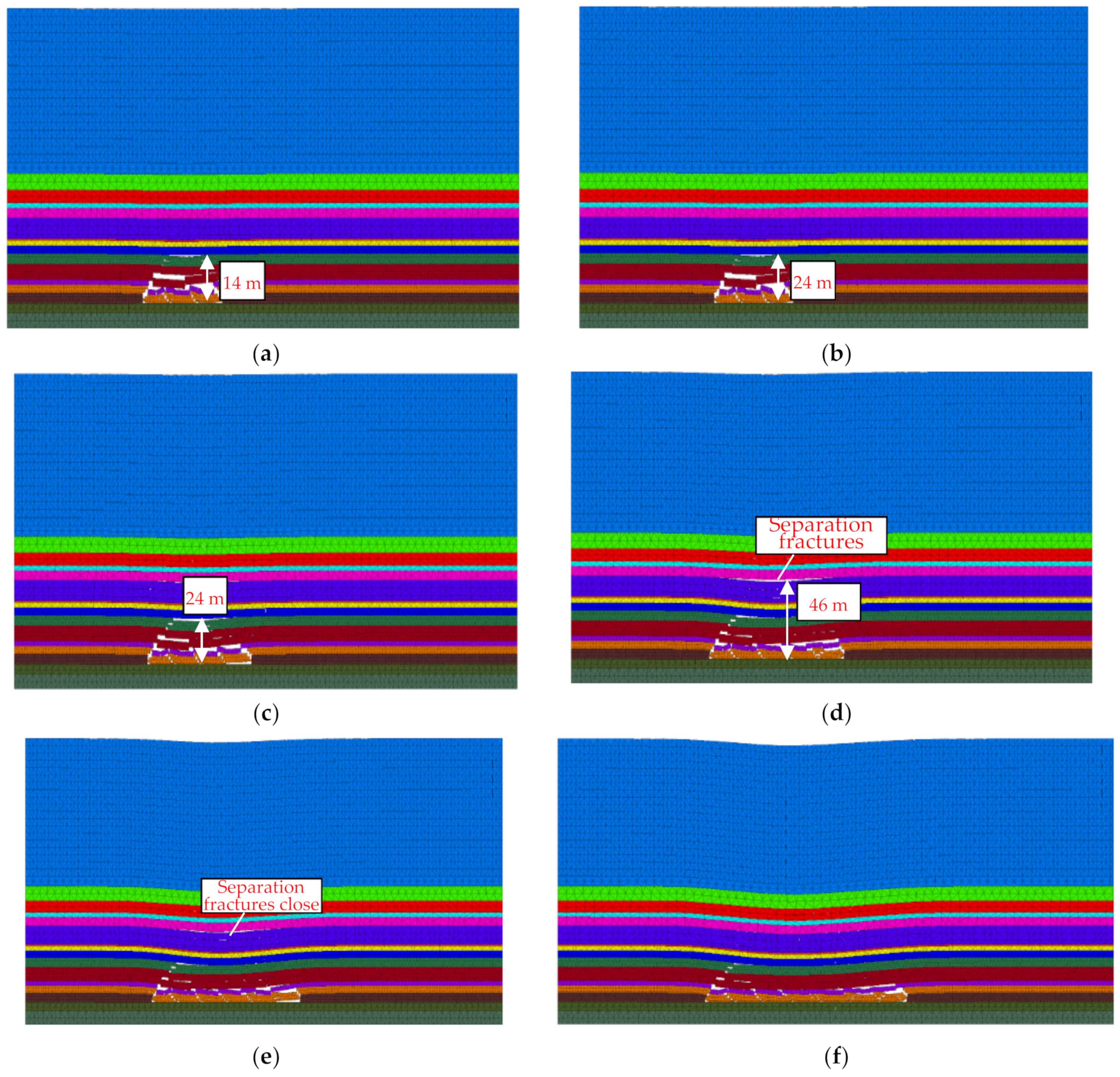
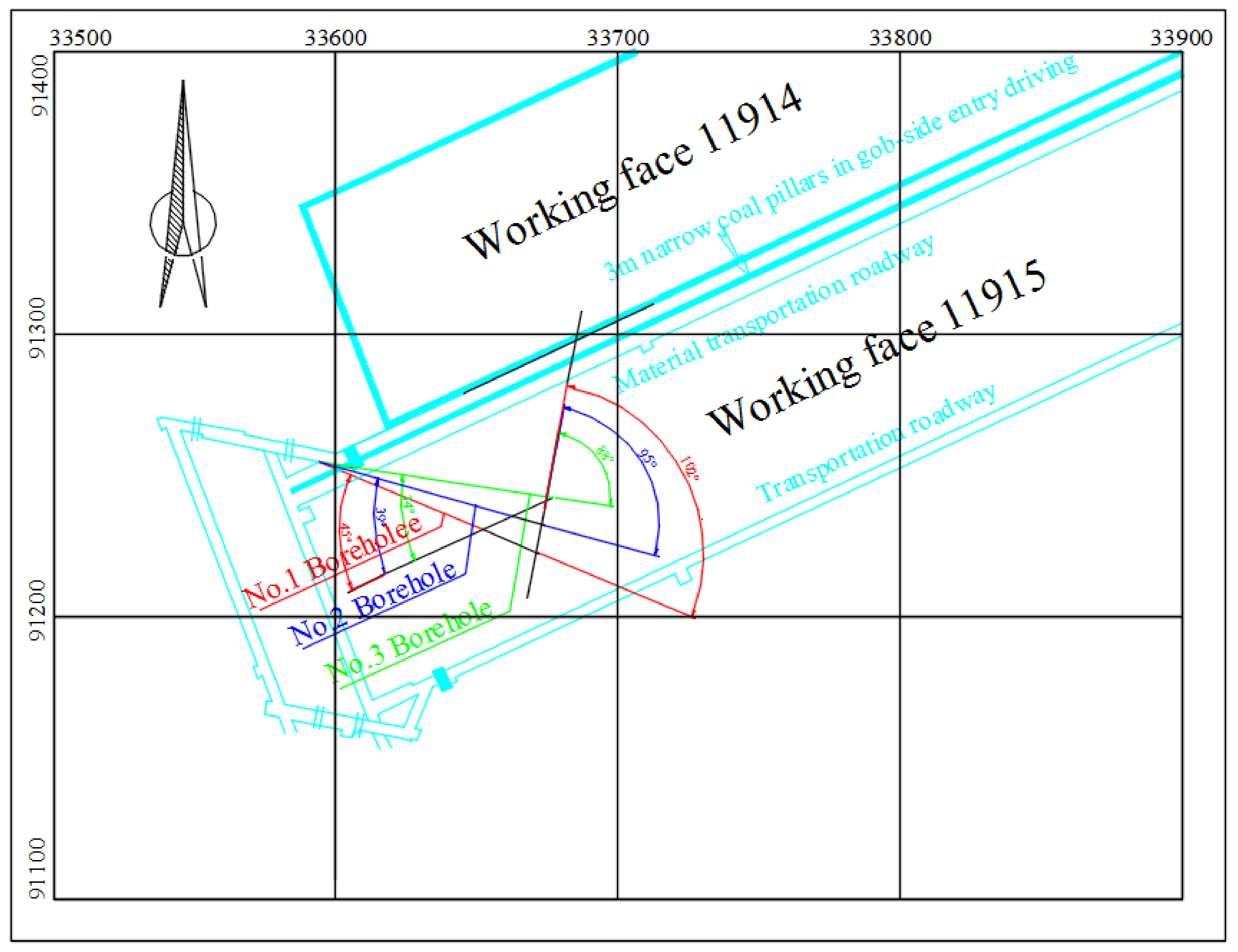

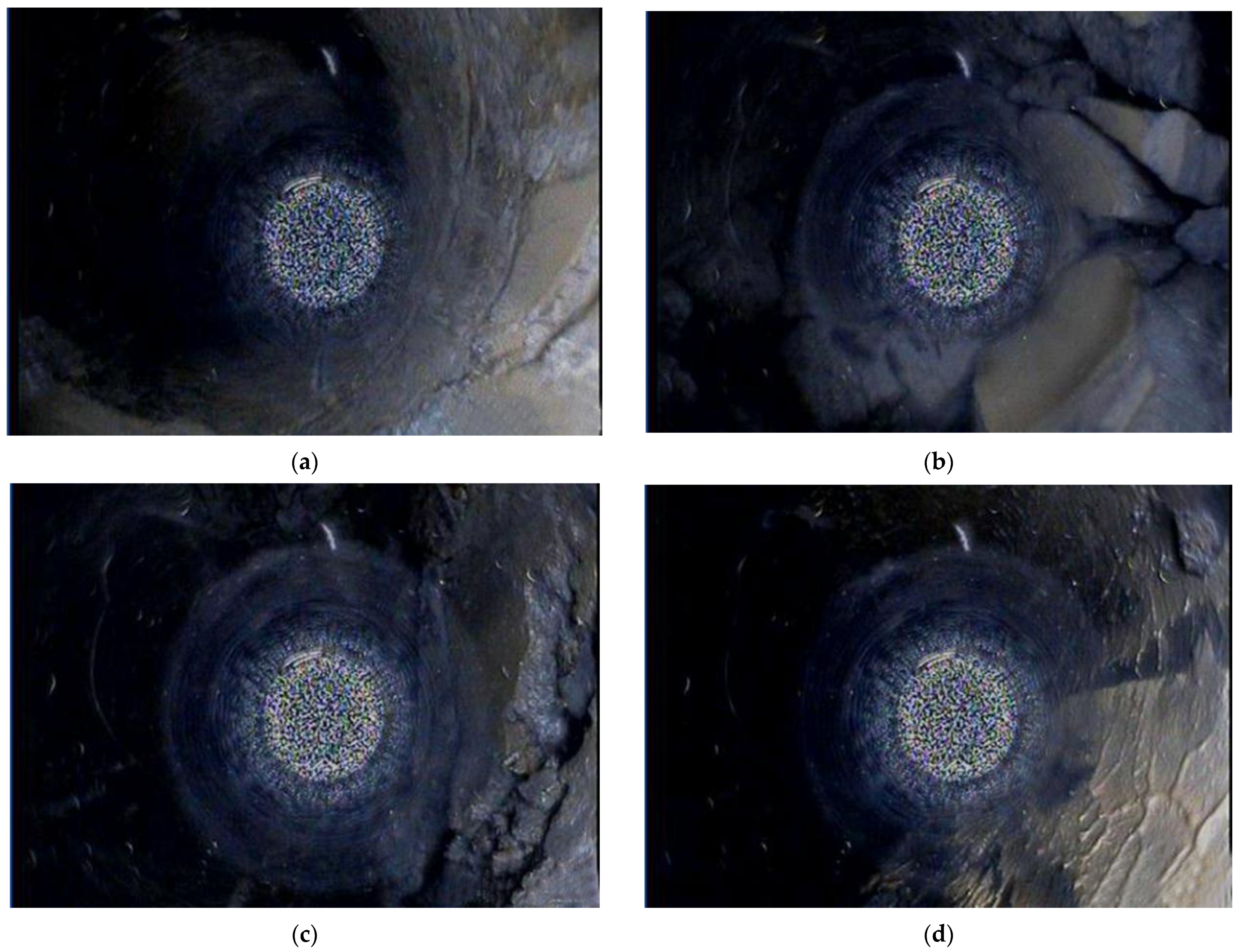


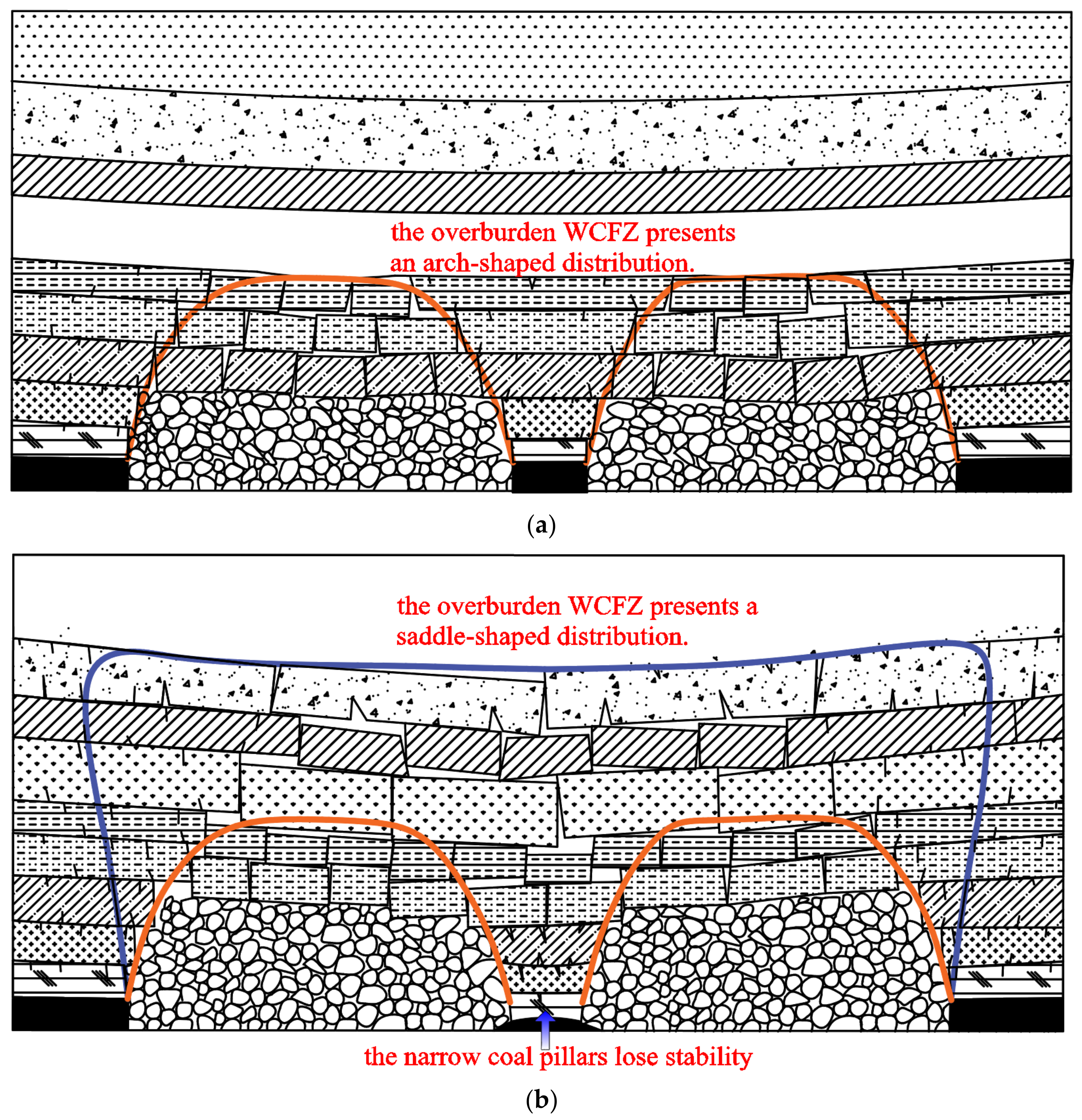
| Lithology | Thickness mi (m) | Evaluation Coefficient Qi | mi × Qi |
|---|---|---|---|
| Limestone | 5.37 | 0.1 | 0.537 |
| Mudstone | 3.39 | 0.8 | 2.712 |
| Limestone | 0.4 | 0.1 | 0.04 |
| Siltstone | 10.15 | 0.5 | 5.075 |
| Inter-bedded siltstone and fine sandstone | 5.8 | 0.6 | 3.48 |
| Medium fine sandstone | 5.27 | 0.4 | 2.108 |
| Coreless section | 2.77 | 0.6 | 1.662 |
| No. 7 Coal | 1.4 | 1 | 1.4 |
| Muddy siltstone | 8.8 | 0.6 | 5.28 |
| Medium sandstone | 5.5 | 0.4 | 2.2 |
| Limestone | 2.5 | 0.1 | 0.25 |
| Siltstone | 7.8 | 0.5 | 3.9 |
| Medium fine sandstone | 10.32 | 0.4 | 4.128 |
| Pebble | 16.85 | 0.8 | 13.48 |
| Clay sand | 64.58 | 1 | 64.58 |
| Pebble | 18.98 | 0.8 | 15.184 |
| Topsoil layer | 0.6 | 1 | 0.6 |
| Total | 170.48 | 126.6 |
| Lithology | Index | Correspondence | ||||||||
|---|---|---|---|---|---|---|---|---|---|---|
| Hard | P | 0.00 | 0.03 | 0.07 | 0.11 | 0.15 | 0.19 | 0.23 | 0.27 | 0.3 |
| D | 0.76 | 0.82 | 0.88 | 0.95 | 1.01 | 1.08 | 1.14 | 1.20 | 1.25 | |
| Moderate Hard | P | 0.3 | 0.35 | 0.40 | 0.45 | 0.50 | 0.55 | 0.60 | 0.65 | 0.70 |
| D | 1.26 | 1.35 | 1.45 | 1.54 | 1.64 | 1.73 | 1.82 | 1.91 | 2.00 | |
| Soft | P | 0.7 | 0.75 | 0.80 | 0.85 | 0.90 | 0.95 | 1.00 | 1.05 | 1.10 |
| D | 2.00 | 2.10 | 2.20 | 2.30 | 2.40 | 2.50 | 2.60 | 2.70 | 2.80 | |
| No. | Lithology | Thickness/m | Bulk Density/kg•m−3 | Bulk Modulus/ GPa | Shear Modulus/ GPa | Tensile Strength/MPa | Cohesion/ MPa | Angle of Internal Friction/° | Normal Elasticity Moduluss/ GPa | Tangential Elasticity Modulus/GPa |
|---|---|---|---|---|---|---|---|---|---|---|
| 1 | Medium fine sandstone | 9 | 2390 | 28.45 | 18.82 | 8.5 | 8.8 | 32 | 0.5 | 0.5 |
| 2 | Siltstone | 15 | 2410 | 28.33 | 18.2 | 9.0 | 9.6 | 32 | 0.4 | 0.4 |
| 3 | No. 9 coal seam | 6.5 | 1300 | 3.71 | 1.91 | 1.8 | 1.0 | 24 | 0.1 | 0.1 |
| 4 | Limestone | 5 | 2800 | 2.45 | 1.31 | 2.7 | 1.1 | 29 | 0.03 | 0.03 |
| 5 | Mudstone | 3 | 2430 | 4.00 | 2.1 | 2.2 | 1.7 | 28 | 0.04 | 0.04 |
| 6 | Siltstone | 10 | 2410 | 9.33 | 5.2 | 3.8 | 2.6 | 31 | 0.09 | 0.09 |
| 7 | Inter-bedded siltstone and fine sandstone | 6 | 2500 | 7.33 | 3.3 | 1.3 | 1.0 | 32 | 0.03 | 0.03 |
| 8 | Medium fine sandstone | 5 | 2410 | 12.45 | 7.11 | 4.2 | 2.5 | 36 | 0.09 | 0.09 |
| 9 | Muddy siltstone | 3 | 2410 | 7.33 | 4.2 | 2.2 | 1.5 | 31 | 0.06 | 0.06 |
| 10 | No. 7 coal seam | 1 | 1300 | 3.71 | 1.91 | 1.1 | 1.0 | 24 | 0.01 | 0.01 |
| 11 | Muddy siltstone | 13 | 2410 | 7.33 | 4.2 | 2.1 | 1.5 | 31 | 0.06 | 0.06 |
| 12 | Medium sandstone | 6 | 2410 | 16.45 | 9.81 | 5.9 | 4.5 | 34 | 0.10 | 0.10 |
| 13 | Limestone | 3 | 2800 | 14.45 | 8.91 | 6.5 | 5.2 | 35 | 0.10 | 0.10 |
| 14 | Siltstone | 8 | 2410 | 6.33 | 4.2 | 3.0 | 2.6 | 32 | 0.04 | 0.04 |
| 15 | Medium fine sandstone | 10 | 2410 | 15.45 | 8.81 | 6.2 | 4.5 | 36 | 0.10 | 0.10 |
| 16 | Topsoil Layer | 102 | 1600 | 3.71 | 1.51 | 1.2 | 0.92 | 18 | 0.01 | 0.01 |
| Construction Location | Borehole No. | Borehole Size/mm | Elevation Angle/° | Azimuth Angle/° | Borehole Length/m | Vertical Depth/m |
|---|---|---|---|---|---|---|
| 11915 Track roadway | 1 (pre-mining) | 89 | 45 | N102 | 83 | 60 |
| 2 (post-mining) | 89 | 39 | N95 | 92 | 60 | |
| 3 (post-mining) | 89 | 34 | N88 | 103 | 60 |
| No. 1 Pre-Mining Borehole (45°) | No. 2 Post-Mining Borehole (39°) | No. 3 Post-Mining Borehole (34°) | |||||||||
|---|---|---|---|---|---|---|---|---|---|---|---|
| Borehole depth /m | Vertical height /m | Flow rate L/min | Borehole depth/m | Vertical height/m | Flow rate L/min | Borehole depth /m | Vertical height /m | Flow rate L/min | |||
| Measured datum | Effective datum | Measured datum | Effective datum | Measured datum | Effective datum | ||||||
| 45 | 31.82 | 4.54 | 4.15 | 57 | 35.87 | 21.69 | 21.3 | 69 | 39.54 | 15.48 | 15.09 |
| No. | Calculation Method | Maximum Height of WCFZ/m | Analysis on the Occurrence Position | |
|---|---|---|---|---|
| 1 | Theoretical calculation | Equation (1) | 40.1–56.5 | The maximum heights of the WCFZ were calculated by the empirical formulae under the mining geological conditions; the values are merely for reference because they vary in a large range. |
| Equation (2) | 60 | |||
| 2 | Numerical simulation | 46 | When the working face advanced to 80 m (74 m inclined length of the GQ 11915 working face), the height of the WCFZ remained 24 m. When the working face advanced to 100 m, the height of the WCFZ developed to a maximum of 46 m. | |
| 3 | On-site detection | Borehole imager observation | 45.54 | The 11915 working face with the width of 74 m |
| Fluid leakage observation | 46.4–47.2 | |||
Publisher’s Note: MDPI stays neutral with regard to jurisdictional claims in published maps and institutional affiliations. |
© 2022 by the authors. Licensee MDPI, Basel, Switzerland. This article is an open access article distributed under the terms and conditions of the Creative Commons Attribution (CC BY) license (https://creativecommons.org/licenses/by/4.0/).
Share and Cite
Tan, Y.; Xu, H.; Yan, W.; Guo, W.; Sun, Q.; Yin, D.; Zhang, Y.; Zhang, X.; Jing, X.; Li, X.; et al. Development Law of Water-Conducting Fracture Zone in the Fully Mechanized Caving Face of Gob-Side Entry Driving: A Case Study. Minerals 2022, 12, 557. https://doi.org/10.3390/min12050557
Tan Y, Xu H, Yan W, Guo W, Sun Q, Yin D, Zhang Y, Zhang X, Jing X, Li X, et al. Development Law of Water-Conducting Fracture Zone in the Fully Mechanized Caving Face of Gob-Side Entry Driving: A Case Study. Minerals. 2022; 12(5):557. https://doi.org/10.3390/min12050557
Chicago/Turabian StyleTan, Yi, Han Xu, Weitao Yan, Wenbing Guo, Qi Sun, Dawei Yin, Yujiang Zhang, Xiaoqiang Zhang, Xiaofei Jing, Xiaoshuang Li, and et al. 2022. "Development Law of Water-Conducting Fracture Zone in the Fully Mechanized Caving Face of Gob-Side Entry Driving: A Case Study" Minerals 12, no. 5: 557. https://doi.org/10.3390/min12050557
APA StyleTan, Y., Xu, H., Yan, W., Guo, W., Sun, Q., Yin, D., Zhang, Y., Zhang, X., Jing, X., Li, X., Wei, S., & Liu, X. (2022). Development Law of Water-Conducting Fracture Zone in the Fully Mechanized Caving Face of Gob-Side Entry Driving: A Case Study. Minerals, 12(5), 557. https://doi.org/10.3390/min12050557










